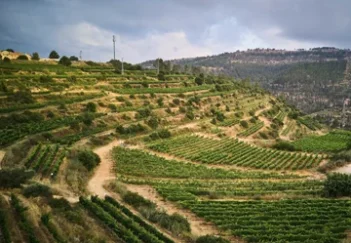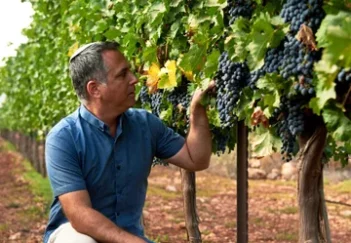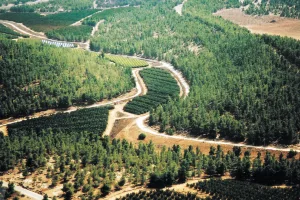The Israel wine industry was really built in the coastal area of Israel, where most of the initial vineyards were planted. Basically vineyards where planted where it was most practical, instead of where the wine potential was best. It was easier for the farmers of the new villages, to plant vineyards near their homes, groves, fields and animals, and that was what they did. So the southern Mount Carmel and the central Judean Plain was where Rothschild’s growers grew their vines. This was more or less the case for 100 years.
When I made aliyah to Israel twenty five years ago, the only place said to make quality wines was the plateau of the Golan Heights. The story goes that when Professor Cornelius Ough from the University of California at Davis visited Israel in 1972, he observed the successful apple industry there and immediately pinpointed the Golan as being suitable for quality wine grapes. The vineyards were first planted in 1976 and when the Golan Heights Winery was formed in 1983, it put the Golan on the wine map as a quality wine producing area
there and immediately pinpointed the Golan as being suitable for quality wine grapes. The vineyards were first planted in 1976 and when the Golan Heights Winery was formed in 1983, it put the Golan on the wine map as a quality wine producing area.vinyards
The high altitude, up to 1,200 meters above sea level, volcanic soil and basalt stone made it the only serious wine producing area in the country. Those who then worked in the wine industry and wine media implied it was the only possible quality wine region in Israel. The success of the Yarden brand in international competitions helped fuel the superlative image.
It was not until the mid to late 1990’s that the Upper Galilee was also added to the quality equation as far as Israeli wine was concerned. Dalton was the first winery established there in 1993 in partnership with an established vineyard. Avi Feldstein, then winemaker of Segal Wines (before it was purchased by Barkan), was one of the first individuals give focus to the quality potential the Upper Galilee. Soon it was realized that the Upper Galilee with its gravelly and terra rossa soils, dense forests, high stony peaks and plunging streams, was particularly good for red wines.
Of course there had been clues previously. The Carmel Special Reserve 1979 was the first quality wine produced from Galilee vineyards. More significantly, the wine that put the Golan Heights Winery on the map was its Yarden Cabernet Sauvignon. Yet one of the finest components of this wine came from the Ramat Naftali vineyard in the Upper Galilee!
In no time, wineries from all over Israel were sourcing their best fruit from the Upper Galilee. Examples were Carmel & Barkan amongst the large wineries, and Recanati, Margalit and Flam amongst the others. By the beginning of the 2000’s, those talking about quality wine regions in Israel began to mention the Golan Heights and Upper Galilee in the same breath.
Another wine region to become noticed was the Judean Hills & Foothills. The pioneer here was Tzora Vineyards founded in 1993 and the legendary grower winemaker, the late and much missed Roni James. He was determined to create wines which reflected the local terroir. Castel Grand Vin was the first wine to have the Judean Hills (Haut Judée) written on its labels as a statement of pride in the appellation. Up to then, only the Golan wines were identified by growing region.
When you take stock now of the awards and high scores from critics at the highest level, it is clear that the Judean Hills does not suffer in the quality stakes in comparison with the Golan and the Galilee. Witness the success of Castel, Clos de Gat, Tzora and others. Apparently the Judean Hills is also one of our best quality regions!
Next the Negev came to the fore. The wine presses at Avdat and Shivta provide evidence of a large wine industry in ancient times and recently the Negev has also come alive again. Carmel was the pioneer in 1988 planting its Ramat Arad Vineyard. The first Negev wine in modern times was their Ramat Arad Merlot 1992.
The Sde Boker Winery first began to make wine on a tiny scale in 1998. When Yatir Winery was formed at Tel Arad it became the first winery situated in an area surrounded by Bedouin and camels. Its Sauvignon Blanc and initial Merlot were from the Ramat Arad vineyard, but eventually they focused on their Yatir Forest vineyards, which lie more in the southern tip of the Judean Hills, than the Negev.
However vineyards planted elsewhere began to make the desert bloom. Barkan and Tishbi in particular started using pioneering vineyards at Mitzpe Ramon and Sde Boker. I still get excited when I travel south and see a green vineyard in the midst of a brown, desolate desert. Next time you fly to Eilat, look out of the window. The patches of green vineyards would make David Ben Gurion proud.
Now with Midbar Winery, situated at Arad and Ramat Negev Winery (Kadesh Barnea), straddling the Negev, and numerous boutique and domestic wineries in between, fine wine has returned to keep the wine presses of Shivta and Avdat company.
The major coming area of the last few years is what I call the Central Mountains. In the beginning there was the Gush Etzion Winery founded in 1998. Arguably one wine lit the fuse that showed the potential here. It was the Har Bracha (Mount Bracha) single vineyard Merlot, produced by Carmel from the 2002 vintage. Since then a new wine region has sprung up with new vineyards planted on these shallow soiled, high altitude limestone hills. Wines, vines and wineries may today be found from Har Bracha in the north to Hebron in the south.
As far as the coastal vineyards are concerned, there is nothing left at Rishon Le Zion, where the first experimental vineyards where planted in 1882. Apparently, real estate has proved more profitable than viticulture. The early photos of Rishon Cellars show what might have been. There are vineyards surrounding the winery, just like a French Chateau. There were even vineyards in the town until the 1970’s. However nothing remains.
So I was especially interested to see that Zichron Ya’acov & Mount Carmel were making a comeback. This was historically were it all began, but never considered the finest region quality wise. I was recently taken by Yair Margalit, one of the icon figures of Israeli wine, to see his new vineyards in Zichron. He has chosen this area to plant his impressive new vineyard to take his winery into the 21st century. What a shot in the arm for the most traditional wine region in Israel!
Finally, whereas the Western Galilee has always nurtured wonderful olive groves, it has never gone into the vineyard business like the Upper Galilee (Merom Hagalil and Kedesh Valley) or the Lower Galilee (Kfar Tabor). However, today the promising Stern Winery and impressive Kishor Winery are breathing wine life into the Western Galilee too. Both are well worth a visit.
So the message is that not only Am Yisrael Hai but also Cremai Yisrael Hai – the vineyards of Israel are alive and thriving, and woe betide anyone who tries to claim a pocket of Israel as the only place where quality wine can be. How wrong we were, twenty five years ago. The Biblical Prophet Amos said: “I will restore the people Israel….They will plant vineyards and drink their wine.” Now, over 2,700 years later, we can firmly announce that this was a prophecy that came true!


















